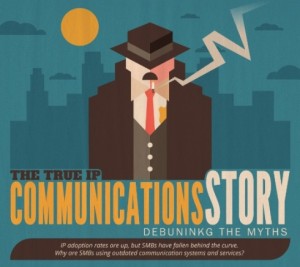— July 10, 2019

When you see “thought leadership” content out in the B2B content marketing landscape, the quality and substance of the ideas often run the gamut from “oh, wow!” to “oh, dear…”. When not executed strategically, thought leadership content may just seem like another box companies are covering on B2B Marketing Buzzword Bingo.
Even though the thought leadership content landscape has been flooded with sub-par execution and obvious ideas, the trend picked up steam for a reason. When executed effectively, it bolsters content marketing efforts and ultimately your lead generation.
With the goal of lead generation in mind, take a look at some of the best ways to ensure that your thought leadership content is valuable to your target audience and drives sales.
What is Thought Leadership?
Thought leadership content is top-tier content, whether it be white papers, blog posts, videos or any form of content that derives itself from thought leaders. Regardless of form, thought leadership pieces are always well-researched, relevant to your particular industry and provide a unique voice on the topic. These markers of excellent thought leadership content increase the likelihood that your company will be recognized as an authority in your industry.
Thought leadership benefits your company in two main ways:
Establish credibility
Positioning yourself as a thought leader increases customer trust, both in your content and in your company. If people within your industry recognize you as a trusted source for content, then they’ll be more likely to trust your products or services, the sales and customer service teams that they communicate with and your business overall.
As author and keynote speaker Andrew Davis said:
“Content builds relationships. Relationships are built on trust. Trust drives revenue.”
Thought leadership content is focused on building connections and introducing new perspectives to existing problems, which helps fortify the relationship between you and your target audience.
Support and shape your content marketing
Just like any form of marketing, thought leadership requires strategy—meaning strong guidelines, voice and focus around your longer term lead generation goals.
Determining key areas you want to be a leader in is essential for creating this focus. Later on, we’ll highlight some of the steps you can take to help organize your thought leadership strategy so it also supports your overarching content marketing strategy.
Core Components of Thought Leadership
Innovation
In order to truly stand out as a thought leader, there needs to be a certain level of new and inventive thinking. Rather than reiterating ideas your target audience is already familiar with, you’ll need to think critically about the topics prevalent in your industry and provide a forward-thinking lens for your readers to examine their most pressing issues. Every industry is changing and facing new challenges or obstacles, so it’s essential that your readers view you as someone who’s going to guide them through these transitions with a fresh perspective and insight to what lies ahead.
Expertise
To be a thought leader, you have to know your subject matter really, really well. So well, in fact, that you would be considered an expert. No organization is likely to be the single, ultimate authority on a topic, but using a wide variety of credible sources, facts and reasoning to support your thought leadership content will support your reputation as a knowledgeable leader in your industry.
Expertise can also be honed from the thought leaders that you choose to highlight. These leading voices will already have a wealth of experience to draw from, so it’s to your benefit to leverage their knowledge for your content as much as you can.
Time
The biggest roadblock to getting your thought leadership marketing up and running is how long it can take for your organization to be recognized as a thought leader. Like any good relationship, trust takes time to build. While you may be creating great thought leadership content on a weekly basis and sharing it on social and with clients regularly, your readership and audience will need time to find and consume the content and start to recognize that you are a trusted authority in your industry.
Each piece of content you create isn’t going to scream “This is thought leadership!” Instead, it will be a subtle note that builds over time within each of your pieces.
How to Build Thought Leadership for Your Organization
Understand what your customers are looking for
Before diving into a thought leadership strategy, you need to remember who you’re creating this thought leadership for: your customers. While becoming a leader in your field can be a real ego boost, you’re gaining this exposure and trust so that you can reach a larger audience—and the right audience.
Knowing what your customers are looking for means doing some important initial research. Keyword research, particularly through Google, can be integral to crafting your content. If you know what your customers are searching for, you can know what answers to provide.
Another great place to do some research is on social media. A lot of thought leadership takes place on social media, since most thought leaders know that this is where their audience is spending a good portion of their time. Gary Vaynerchuk, Tony Robbins and Christy Wright are examples of some of the thought leaders who employ social media to regularly communicate with their audience on the platforms they already engage with.
Pinpoint the voices you want to highlight
Social media brings us to another important point: the saturated thought leadership market. On one hand, we’re fortunate to have many strong voices discussing important topics, whether it be through social media, blog posts or speaking events. While the number of thought leaders can feel daunting, it can also be a valuable resource for research. Use those other thought leaders in your industry as a point for comparison. It’s not about taking anyone’s ideas, but instead lending your unique voice, research and perspective to the topics that are already being discussed.
A great place to find your unique voice is to look at the voices that are already talking in your organization. Whether it’s your CEO, CTO or Marketing Manager, there are leaders within your organization from which you can pull great ideas, experiences and content inspiration from. Sitting down to have an interview with some of these key players and then turning that interview into content can be a great place to start. Your customers will love to hear directly from your thought leaders and get some insight into the kind of company culture at play within your organization.
How Thought Leadership Supports Lead Generation and Content Marketing
Valuable content leads to valuable leads
So how can thought leadership spur the lead generation returns your sales team is always wanting more of? By positioning yourself as a leader in your industry, you’ll experience greater exposure. In fact, from blogs alone, HubSpot found that companies that blog versus those that don’t have 434% more indexed pages, creating stronger SEO. While this will initially pull in lots of traffic overall, there’s a good chance that a large portion of that traffic will not be your ideal audience.
However, the thoughtful, researched and insightful aspect of your content is what will help keep around those leads looking for real value. If you’re creating thought leadership content that truly resonates, your ideal audience will gravitate towards it and seek you out for not only their content needs, but also their product and business needs.
Ultimately, what you’re really looking for is not a ton of low-quality leads that go nowhere, but instead a select group of quality leads that will result in improved customer longevity and continued partnerships.
Content ready to share
Your sales team will also benefit from having top-quality content readily accessible. With a variety of blog posts, white papers, videos and other thought leadership content in their arsenal, they can easily provide the content that is most relevant to individual prospects.
The content can also be shared by your thought leaders. Those key voices we discussed earlier should have active social channels that they can share the content on, allowing your pieces to reach a larger audience and align those thought leaders with the content itself.
Thought leadership is a valuable tool to utilize as content marketers, but it’s also an important device to leverage for your lead generation efforts. The great and insightful content that marketers create sets off a chain reaction within your organization, as the content bounces between different teams and eventually cascades into the bottom of your funnel for sales to scoop up and take to the finish line. Do yourself, your organization and your customers a favor by strengthening the voice and resolve of your content marketing through thought leadership.
Business & Finance Articles on Business 2 Community
(36)







